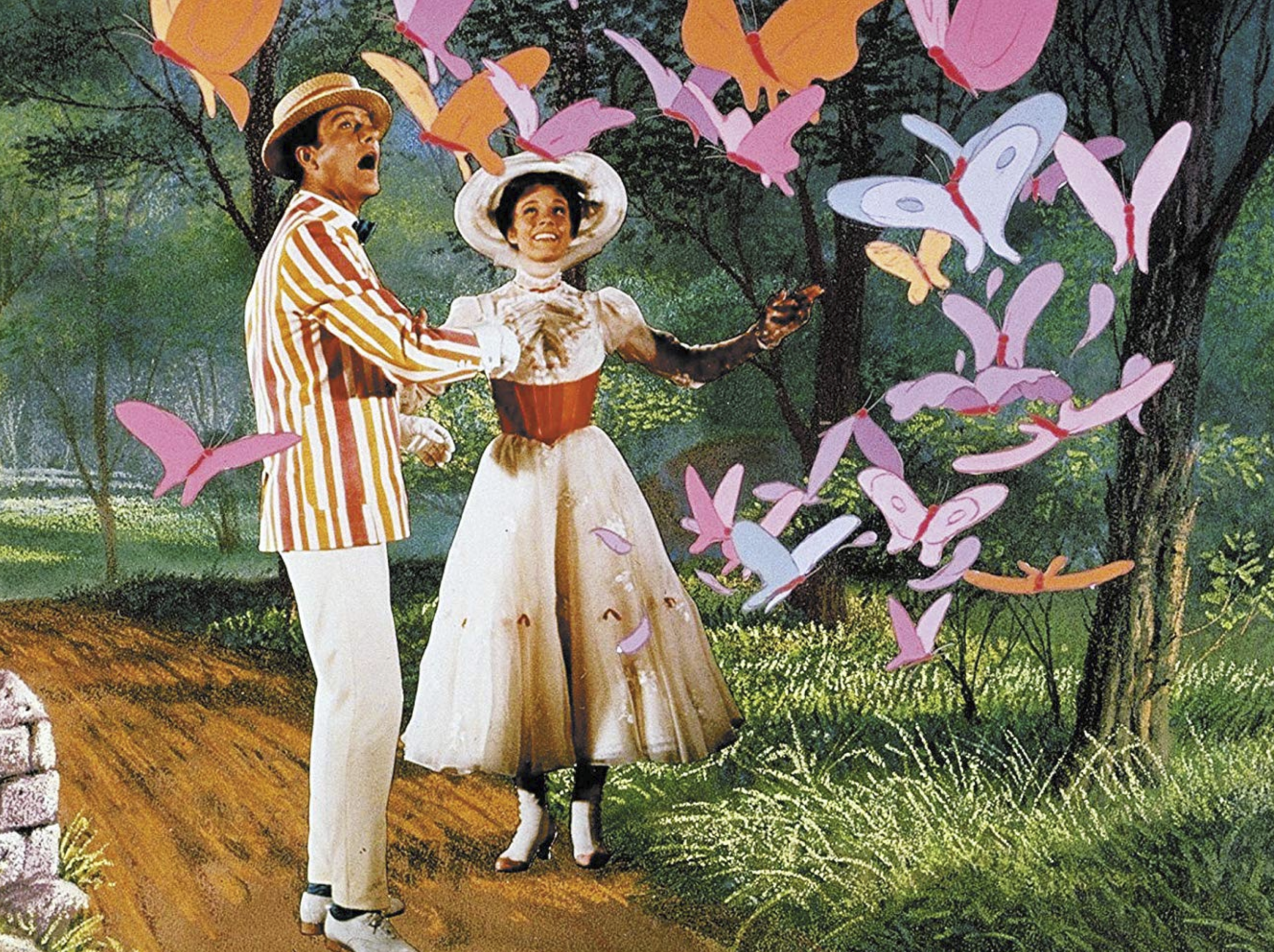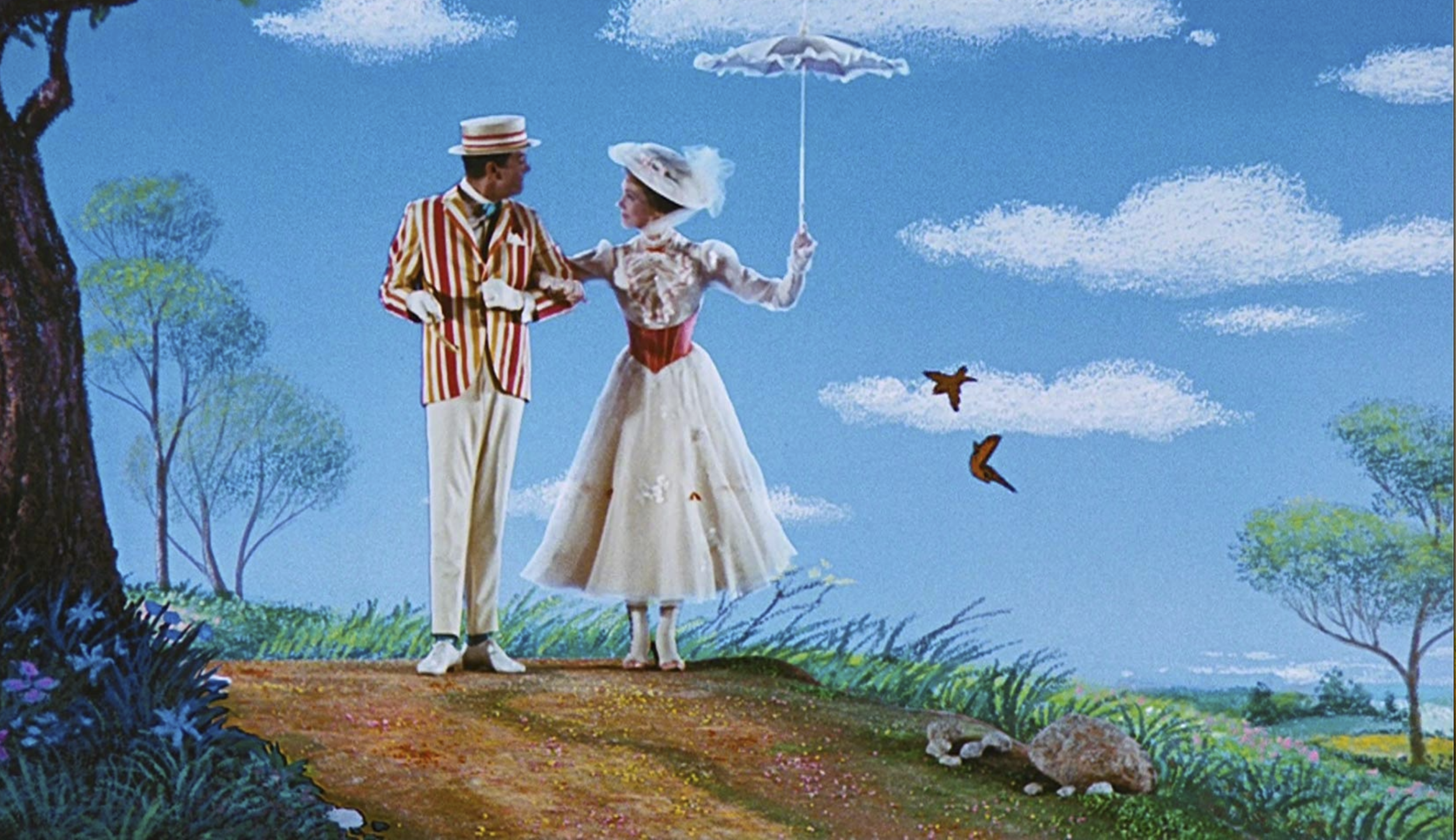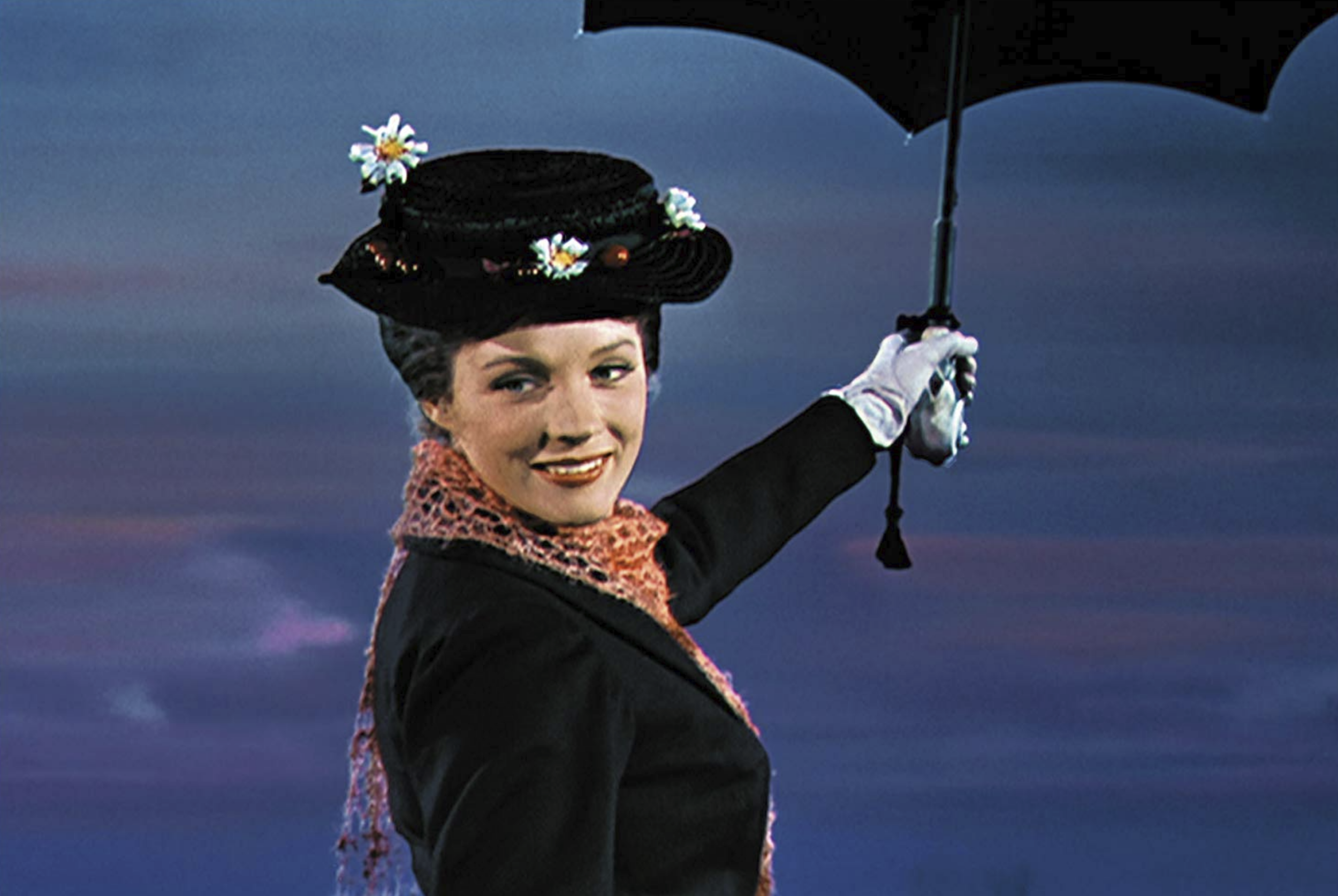Julie Andrews and Dick Van Dyke in Mary Poppins (1964) - © 1964 Walt Disney Productions
Co-written by Savannah Sivert & Taylor Hinds, Edited by Liberté Grace
Julie Andrews has captivated audiences on the stage and screen for decades. She is a cultural icon who is considered one of the last living Hollywood legends in the business. As an Oscar-winning actress, she is best known for her four-octave soprano voice and her titular lead roles in Mary Poppins and The Sound of Music. Andrews and her daughter, Emma Walton Hamilton, have co-authored over twenty books together. Their latest book, Home Work: A Memoir of My Hollywood Years was released earlier this fall.
Home Work acts as a continuation of her first memoir, Home: A Memoir of My Early Years, which delved into her challenging childhood, her first experiences establishing herself as a singer and performer in the UK, and her early years on Broadway. Her latest edition covers over twenty years of her renown filmography, providing in-depth insights into how she balanced her family life and work—from her unexpected casting in Mary Poppins, to her final project with her late husband Blake Edwards; That's Life.
Julie Andrews accepts the Golden Lion Award at Venice Film Festival 2019 | Photo by Theo Wargo/Getty Images Entertainment / Getty Images
This year, Andrews was a special guest at the Venice Film Festival where she was presented with the prestigious Golden Lion Award. While at the festival, Andrews participated in a Masterclass; offering insights into her latest book and her experiences in the entertainment industry during her golden years. Giulia D’Agnolo Vallan hosted the Masterclass, where Andrews attracted a standing-room-only audience of cinephiles and international press. Here are the highlights from the conversation:
The book’s timeframe covers your Hollywood years; from Mary Poppins to That's Life. So, I think we're going to have to start with Poppins and the day that Walt Disney walked into your dressing room. Andrews was already very well-known on Broadway. She had done My Fair Lady and she was in Camelot. When Walt Disney walked into your dressing room, what happened?
JA: Well, I thought he was coming to say he enjoyed the show or something. But, he said, would I be interested in coming to Hollywood to hear the songs and see what he was doing for a new film Mary Poppins, and I said, "Oh Mr. Disney, I would love to...but I'm pregnant. I'm 3 months pregnant." And he said, "That's ok, we'll wait.”
Julie Andrews with Walt Disney at the Hollywood premiere of Mary Poppins (1964) - Courtesy of Gettys
Mary Poppins was a very, very advanced film for its time; it was a mix of animation and real life. Can you talk a little bit about that?
JA: In those days, they didn't have all the extra bells and whistles that they have now for film, for animation and live-action mixes. So, the amazing thing today is that, even now, you do not see a single crack in Mary Poppins.
Mary Poppins is still one of your most iconic characters and I'm wondering, how did you find her body language, her walk?
JA: Two things: First of all, Tony Walton’s costumes and designs. He said to me, "I think Mary Poppins has a little secret life somewhere, and if you look inside the lining of her jackets or the petticoats of her skirts, there are many colours and quite pretty. Everything outside is very formal and everything inside is a little bit bright and wicked. And even the daisy in her hat is just a little bit sparkling.
And it gave me the idea that she did have a secret life altogether; that she had another personality, which was a little more playful and fun. And the second thing is crazy—when I was doing My Fair Lady, I noticed that I turned my feet in to begin with when I was just the cockney girl, but for Mary Poppins, I suddenly decided to turn my feet outwards. I guess I act with my feet, all the way up to my head!
Immediately after Mary Poppins, you were sought after by Robert Wise, and also by Arthur Hiller. It’s counter-intuitive, your second film, The Americanisation of Emily; it's black and white and it’s an anti-war comedy.
JA: The thrill was to be asked to make this movie. Also, I think I knew that I was going to do or had been asked to do, The Sound of Music. And I thought, doing The Americanisation of Emily would not be so type-casting, and I could really try something different. I was very happy with that second movie—to be asked to do it.
One thing that I was surprised to hear, because The Sound of Music is one of your most beloved films, is that you were hesitant. Having seen the Broadway production, you thought that it was too sentimental.
JA: The danger was that it could be over-the-top saccharine. I mean, you have mountains, and nuns, and children, and wonderful, wonderful things. But, all together and seven children? So I decided I would get the director Robert Wise, who also felt the same way, to be astringent as we could with such a subject, and I think it made a difference. It's still a very sweet and loving sentimental film. But we saved a lot of it from being too saccharine.
And wasn't Christopher Plummer instrumental?
JA: He was our glue that held our film together. Robert Wise was masterful. But, Christopher was so good as the captain and he was so astringent, it was lovely.
Do you have a favourite scenes from the film?
‘Sound of Music’ (1965) Opening scene - Courtesy of 20th Century Fox
JA: So many, many, many memories of the cold in the mountains and waiting and waiting. So much rain. Nobody told the producers that Salzburg has Europe's seventh-highest annual rainfall and every day—rain, rain, rain. So we would sit and wait, and wait, and be cold, then maybe, a little bit of sun, and then, we would rush out and get the shot.
Andrews and her second husband, Blake Edwards collaborated on a total of seven films. Together, they created such trend-setting comedies as 10, centred around a man’s mid-life crisis-induced crush on a young paramour, which became one of the highest-grossing box office hits of 1979; and S.O.B, a film known for its brash representation of Hollywood, which advertised Andrews as ‘America’s sweetheart’— bare-chested.
Their last film, That’s Life, was shot in their family home and considered by Andrews, to be their most biographical. One of their most well-known collaborations, Victor Victoria, was a film ahead of its time. Made in 1982, the story centres around a woman pretending to be a cross-dressing man in 1930’s France.
Victor Victoria (1982) - Courtesy of Metro-Goldwyn-Mayer
The main characters each had their own confusions to overcome, albeit their gender or sexuality. After its release, it was largely reviewed as Edwards’ best work and Andrews won the Golden Globe for Best Actress. Over 35 years later, it is still revered as one of the most important “gay-forward” films to grace the big screen.
In Andrews honour, a screening of Victor Victoria took place at the festival, captivating audiences with its forward-thinking plot, slapstick comedy, and big musical numbers, just as it did when it was initially released.
And it is just amazing because [Edwards and Andrews’ collaboration] feels like such a partnership. If you want to give us a little bit of an idea of how you two were collaborating. I mean all these films…he wrote the roles for you.
JA: It’s hard to explain. I think he understood me very well and I think he saw that I wasn’t just a ‘goodie-two-shoes,’ if you know what that is. I wasn’t all prim and proper like Mary Poppins. There may be some comedy there. There may be something else as well. He saw that and developed it for when we worked together. But also, I understood him all so very well. We were married 41 years and we knew each other 44 years. So, there was a lot of time to get to know how we worked. He was funny, irreverent and full of joy.
On the set of 1982's Victor Victoria - Courtesy Getty Images
And I think Blake and your work together was very much a force of change with the times.
JA: Yes, and very innovative. His films like 10 and Victor Victoria, for instance, were all (done) with a fresh take. A new idea. To write in10 about a kind of middle-aged male crisis—it was not the first time, but I think it was a very important film for that story and funny. I mean Dudley Moore was so adorable in 10. And S.O.B. was an especially interesting movie because it was really Blake’s...would you call it revenge?
A little bit.
JA: A little bit of revenge for getting back at Hollywood, because, in the early days with Blake, he did not have the final cut. Quite often, the heads of the studio would say, “No. We will take this out and this out.” And they would take out what Blake thought was the most important pieces and destroy his movies. So he wrote S.O.B. as a “got you,” you know.
What I understood was, he really wrote a satire on my image. Sally Miles called ‘Smiled’ in the movie, was a good, good lady, and known for playing Peter Pan in her youth. So, eventually, her husband in the movie makes a big flop, and he decides to remake this film into a pornographic movie for his wife—his star. And it is really very witty, very funny, very satirical.
And this brings us to the movie that we screened yesterday, which was one of our most beautiful—Victor Victoria. Is it true that you were worried, at the beginning, that the audience wouldn’t believe you?
Victor Victoria (1982) Trailer - Courtesy of Warner Bros.
JA: Yes, I said to my husband: “In Victor Victoria, I play a woman who plays a man who pretends to be a woman and that is like patting your head and rubbing your stomach.” I didn’t [know] which one I was. Was I today the woman or was I today the man? So I was very worried that the audience—I said to my husband, “They will never believe, I don’t think, based on my image, that I could be a man. They couldn’t.”
And he said, “Darling, don’t worry, I will make the audience in the movie believe that you are a man, therefore, the audience watching the movie will go along with that.” And they did. He was wise that way.
I was watching the movie a few weeks ago to prepare for this and your body language is amazing.
JA: Well, I didn’t know what to do at first. So, I studied, which I was very happy about. I studied men a great deal. And what is the difference? What do they do? How do they sit? Ladies use their hands a lot and their expressions a lot. Men sit with their legs wide and their hands in their pockets or something like that, or keep more—mostly, more still.
I thought, “Well, that’s one thing I can do.” And then, I dropped my voice a lot. I mean, from being normal, I would drop my voice way down here [lowering her voice]. It was kind of interesting, but always like walking on a tightrope for me.”
Julie Andrews won our hearts with her family-friendly roles in Mary Poppins and The Sound of Music. Her collaborations with Blake Edwards challenged our sensibilities of what it is to be a husband, a Hollywood star, and of course a cross-dressing man. Forever ingrained into culture, Andrews’s legacy exemplifies the resilience of a true artist.
In her acceptance speech for the Golden Lion Lifetime Achievement Award, Andrews left a packed house with a final tribute to her fans :
“I want to thank you and all the audiences here and around the world, who remain so passionate about the value of the cinema. You make all of this, all that we do, possible. And your continued support keeps the magic alive on the screen for all of us.”
Her New York Times best seller Home Work: A Memoir of My Hollywood Years was released on October 15 and is now available on Amazon.
about the actor
Julie Andrews
Actor, Writer
Julie Andrews came from a family of vaudeville performers who discovered her freakish but undeniably lovely four-octave singing voice and immediately got her a singing career. She performed in music halls throughout her childhood and teens, and at age 20, she launched her stage career in a London Palladium production of Cinderella. Andrews came to Broadway in 1954 with The Boy Friend, and became a bona fide star two years later in 1956, in the role of Eliza Doolittle in the unprecedented hit My Fair Lady. Her star status continued in 1957 when she starred in the TV-production of Cinderella (1957) and through 1960 when she played Guenevere in Camelot. In 1963, Walt Disney asked Andrews if she would like to star in his upcoming production, a lavish musical fantasy that combined live-action and animation. Andrews made an auspicious film debut in Walt Disney's Mary Poppins (1964), which earned her an Academy Award for Best Actress. Andrews continued to work on Broadway, until the release of The Sound of Music (1965), the highest-grossing movie of its day and one of the highest-grossing of all time. She soon found that audiences identified her only with singing, sugary-sweet nannies and governesses, and were reluctant to accept her in dramatic roles in The Americanization of Emily (1964) and Alfred Hitchcock's thriller Torn Curtain (1966).















